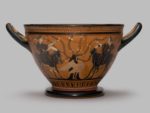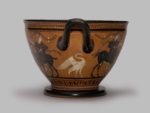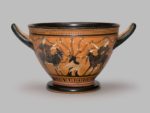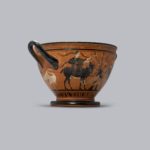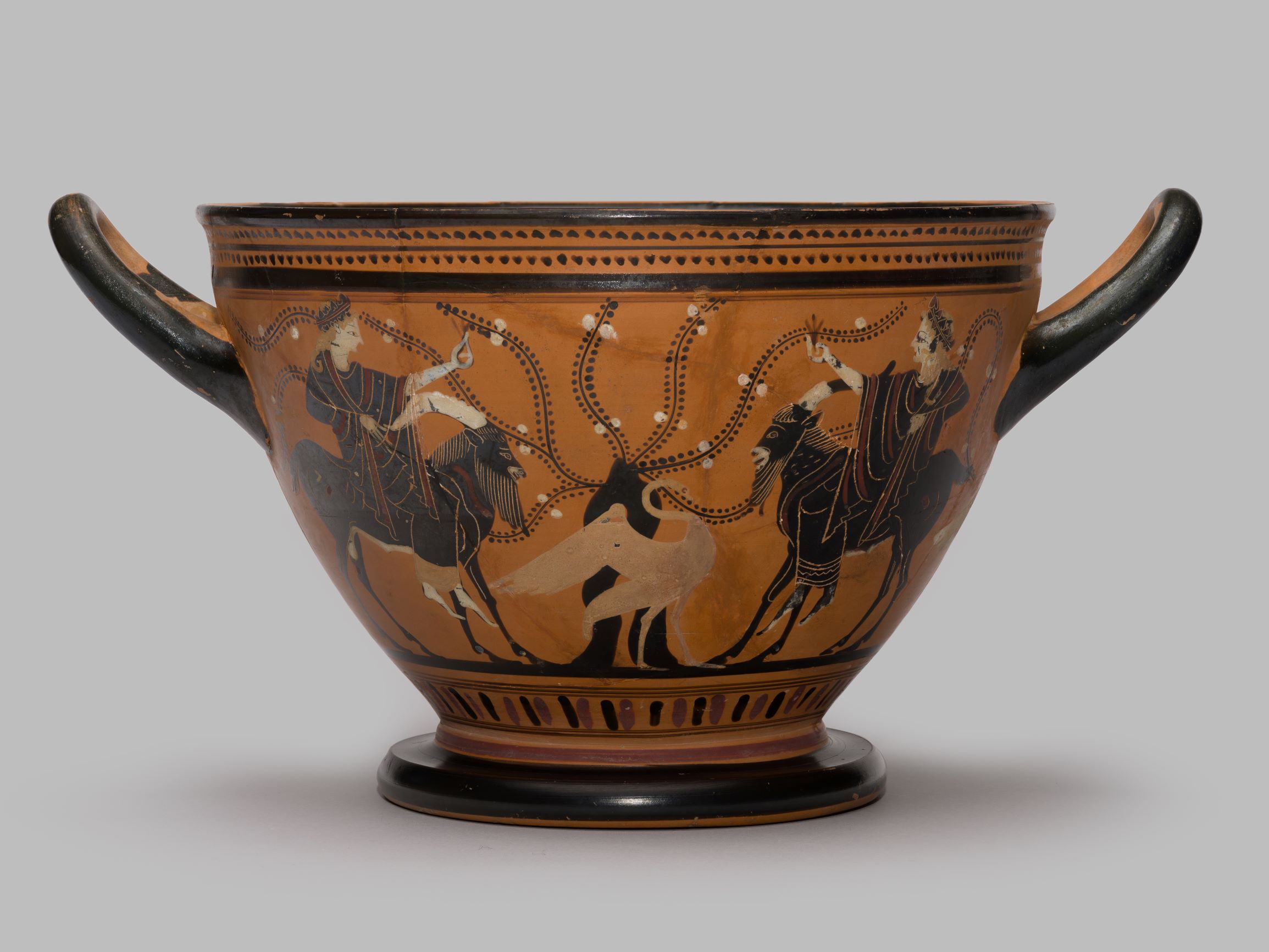
Skyphos [Gr12]
Athenian Black-Figure, by the Theseus Painter, 520-500 BC
Painted terracotta (h. 15.1 cm, w. 29.5 cm), mended
On each side two maenads riding goats, between them a tree with branches holding white fruit; white herons in front of the trees and beneath the handles. The upper border decorated with two bands of ivy leaves, and the lower border with alternating red and black strokes.
The women riding goats are maenads – female followers of the wine god Dionysus. They wear ivy wreaths, marking them out as devotees of the god. Their hair falls over their shoulders, as if dishevelled by the wild frenzy of Dionysian rituals. Each of the maenads holds a flower in her outstretched arm. Goats were sacrificed to Dionysus, and satyrs, the male companions of the god, have goat-like features. Although Dionysus is particularly associated with the vine, he was believed to have discovered all tree-fruits and was associated in general with fertility and growth, hence the flowers held by the maenads and the fruit tree behind them.
This skyphos (cup) is a fine example of the use of added colour in black-figure vase painting. Yellow has been used for the herons in front of the trees and the maenads’ hair; white for the maenad’s flesh, the herons below the handles, the goats’ bellies and hoofs; red for the stripes on the maenad’s himatia (outer garments), their ivy wreaths and tainiai (headbands), and the dots of the eyes of maenads and herons. These colours, together with the use of incision, gave the painter an opportunity for subtle variations in the dress of the four maenads and the horns of the goats. The convention of painting female flesh white was abandoned when the red-figure technique overtook black-figure in the decades around 500 BC, and other ways were devised to differentiate between the sexes.
The painter of this cup is known as the Theseus Painter because several of his surviving vases show scenes from the legend of Theseus. At least two hundred vases have been attributed to him, more than almost any other painter. Another cup decorated by him is in the Winchester Collection (Gr8). The Theseus Painter seems to have begun his career in the Krokotos workshop (see Gr7), with which his work has many stylistic similarities. He was active from about 520 to 480 BC, a period when the red-figure technique came to dominate Athenian vase painting. The Theseus Painter seems to have been the last really accomplished and inventive painter to work in black-figure. His vases have been found as far afield as Cyrene (in modern-day Libya), the west coast of Italy, Thasos and Rhodes. In common with several other cups by the Theseus painter, and many of those decorated by the Krokotos workshop or under its influence, this skyphos includes the distinctive figure of a white heron underneath each handle (there are also yellow herons on both sides).
Literature: R. Foster, Winchester College Treasury: a guide to the collections (Winchester, 2016), pp. 46-47; O.E. Borgers, The Theseus Painter: Style, Shapes and Iconography (Amsterdam, 2007), no. 4 (pp. 143-44), plate 1.c-d, figs. 24, 29, pp. 16, 19, 21, 27, 29 (n. 174), 31-32, 39, 66-68, 74 (n. 449), 80, 101; J. Falconer and T. Mannack, Corpus Vasorum Antiquorum: Great Britain, Fascicule 19: Winchester College (Oxford, 2002), p. 4, plate 3.5-8; T.H. Carpenter, T. Mannack and M. Mendonça, Beazley Addenda (Oxford, 1989), p. 129; C.A. Picón, Classical Antiquities from Private Collections in Great Britain (London, 1986), p. 22 (no. 14), plate III; J.D. Beazley, Attic Black-Figure Vase-Painters (Oxford, 1956), p. 518.36; A.D. Ure, ‘Krokotos and White Heron’, Journal of Hellenic Studies 75 (1955), pp. 95-96, 99 (n.48), 103; J. Chittenden and C. Seltman, Greek Art, a Commemorative Catalogue of an Exhibition held in 1946 at the Royal Academy (London, 1947), p. 7 (no. 75), plate 15; N. Oakeshott, ‘Three Black-figured Vases in the Winchester College Museum’, Journal of Hellenic Studies 59 (1939), p. 283-6, plate 15; C. Haspels, Attic Black-figured Lekythoi (Paris, 1936), p. 251, no. 36; Winchester College Memorial Buildings: Department of Classical Art (Winchester, 1909), p. 16 (no. 38)
Exhibited: Royal Academy of Arts, Burlington House, London, 15 February – 17 March, 1946, no. 75; Sotheby’s, London, 1986
Provenance: From Athens, at Winchester College by 1909
Location: Treasury, Gallery 3
